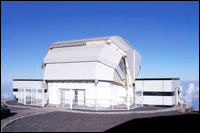World’s largest robotic telescope ready for action

The Liverpool Telescope, the world’s largest fully robotic telescope, has snapped its first images of the heavens this week. This 2 meter optical telescope is owned by the Astrophysics Research Institute (ARI) of Liverpool John Moores University (JMU), but observes autonomously from its site on La Palma in the Canary Islands. The telescope was designed, constructed and commissioned by Telescope Technologies Ltd., a subsidiary company of JMU.
The Liverpool Telescope’s unique capabilities of flexible scheduling and rapid response will put the UK at the forefront of exciting new fields of research in time domain astrophysics. “This enables us to study such phenomena as supernovae and Gamma Ray Bursts – the biggest explosions in space,” said Professor David Carter of the ARI. The telescope’s other great strength is its ability to make regular observations of objects that vary over periods from seconds to years. This is very difficult with current astronomical facilities. It can also track newly discovered objects such as comets or near-Earth asteroids, allowing accurate calculations of their paths and potential hazard.
The telescope is supported by the Particle Physics and Astronomy Research Council, making 40% of the observing time available to astronomers throughout the UK. A further 5% of the time has been donated by JMU to the National Schools’ Observatory (NSO) programme. “School children can now work on their own projects alongside professional astronomers,” said Dr. Andy Newsam (NSO astronomer). This is the first time regular access has been granted to schools on world-class research telescopes.
Media Contact
More Information:
http://www.astro.livjm.ac.ukAll latest news from the category: Physics and Astronomy
This area deals with the fundamental laws and building blocks of nature and how they interact, the properties and the behavior of matter, and research into space and time and their structures.
innovations-report provides in-depth reports and articles on subjects such as astrophysics, laser technologies, nuclear, quantum, particle and solid-state physics, nanotechnologies, planetary research and findings (Mars, Venus) and developments related to the Hubble Telescope.
Newest articles

Superradiant atoms could push the boundaries of how precisely time can be measured
Superradiant atoms can help us measure time more precisely than ever. In a new study, researchers from the University of Copenhagen present a new method for measuring the time interval,…

Ion thermoelectric conversion devices for near room temperature
The electrode sheet of the thermoelectric device consists of ionic hydrogel, which is sandwiched between the electrodes to form, and the Prussian blue on the electrode undergoes a redox reaction…

Zap Energy achieves 37-million-degree temperatures in a compact device
New publication reports record electron temperatures for a small-scale, sheared-flow-stabilized Z-pinch fusion device. In the nine decades since humans first produced fusion reactions, only a few fusion technologies have demonstrated…





















